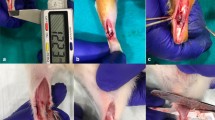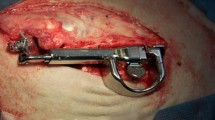Summary
Based on clinical studies, it has been proposed that conservative treatment of Achilles tendon ruptures is feasible. However, no biomechanical or biochemical confirmation of this proposal has been presented. In the present investigation the biomechanical and biochemical properties of tendons treated surgically and conservatively after transverse tenotomy were studied. Sixty-eight New Zealand White rabbits were used. A transverse tenotomy of the plantaris longus tendon of the left hind leg was performed. In half of the animals the tenotomy was repaired with a criss-cross silk suture and the limb was immobilized; the other half were treated with immobilization alone. The immobilization was maintained for 4 weeks with a long-leg plastic splint in both groups. After 4, 8, and 16 weeks the tendons were examined regarding biomechanical and biochemical parameters. There were no detectable differences in biomechanical parameters or in tendon elongation between the groups, nor was there any difference in the total hydroxyproline content, the amount of mature and of immature collagen, or the water content. The present findings are compatible with previous favorable reports on conservative treatment of Achilles tendon ruptures and thus suggest interesting clinical possibilities.
Zusammenfassung
Aufgrund klinischer Beobachtungen ist die Auffassung vertreten worden, daß die konservative Behandlung der Achillessehnenruptur vorteilhaft ist. Jedoch fehlt es an biomechanischen und biochemischen Nachweisen dafür. In der vorliegenden Studie wurden die biomechanischen und biochemischen Eigenschaften von Achillessehnen nach einer queren Tenotomie, die entweder genäht oder konservativ behandelt wurde, untersucht. Achtundsechzig New-Zealand-White-Kaninchen bekamen eine quere Tenotomie an der Sehne des M. plantaris longus am linken Hinterbein. Die Tenotomie wurde dann in der Halfte der Falle mit einer „criss-cross”-Naht (Seide) repariert und das Bein ruhiggestellt, während die andere Hälfte der Versuchstiere nur mit Ruhigstellung behandelt wurde. Die Ruhigstellung des Beines erfolgte vier Wochen lang in einem die ganze Extremität umfassenden Verband aus Hexalite. Nach vier, acht und 16 Wochen wurde die Sehne auf ihre biomechanischen und biochemischen Eigenschaften untersucht. Wir sahen keinen Unterschied in den biomechanischen Eigenschaften oder in beobachteten Sehnenverlängerungen in den beiden Gruppen. Auch der Gesamtgehalt an Hydroxyprolin, der Anteil von reifem und unreifem Kollagen und der Wassergehalt waren ohne Unterschied. Die Ergebnisse dieser Untersuchung stimmen überein mit früheren Berichten über die Vorteile der konservativen Behandlung bei der Achillessehnenruptur und sind klinisch bedeutungsvoll.
Similar content being viewed by others
References
Butler DL, Grood ES, Noyes FR (1978) Biomechanics of ligaments and tendons. Exerc Sport Sci Rev 6:126–181
Gillies H, Chalmers K (1970) The management of fresh ruptures of tendon achilles. J Bone Joint Surg [Am] 52:337–343
Lea R, Smith L (1972) Non-surgical treatment of tendon achilles rupture. J Bone Joint Surg [Am] 54:1398–1407
Mason ML, Allen HS (1941) The rate of healing of tendons. Ann Surg 113:424–459
McIntosh JEA, McIntosh RP (1980) Mathematical modelling and computers in endocrinology. Monographs on endocrinology, vol 16. Springer, Berlin Heidelberg New York
Nistor L (1981) Surgical and non-surgical treatment of Achilles tendon rupture. J Bone Joint Surg [Am] 63:394–399
Nyström B, Holmlund D (1983) Experimental evaluation of immobilisation in operative and non-operative treatment of Achilles tendon rupture. A radiographic study in the rabbit. Acta Chir Scand 149:669–673
Piez KA (1968) Cross-linking of collagen and elastin. Annu Rev Biochem 37:574
Stegemann H, Stalder KH (1967) Determination of hydroxyproline. Clin Chim Acta 18:267
Viidik A (1968) Elasticity and tensile strength of the anterior cruciate ligament in rabbits as influenced by training. Acta Physiol Scand 74:372–380
Author information
Authors and Affiliations
Rights and permissions
About this article
Cite this article
Carlstedt, C.A., Madsen, K. & Wredmark, T. Biomechanical and biochemical studies of tendon healing after conservative and surgical treatment. Arch. Orth. Traum. Surg. 105, 211–215 (1986). https://doi.org/10.1007/BF00435482
Received:
Issue Date:
DOI: https://doi.org/10.1007/BF00435482




